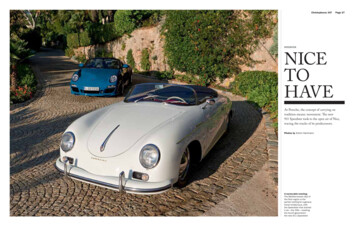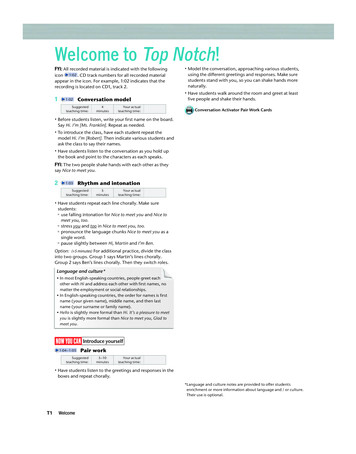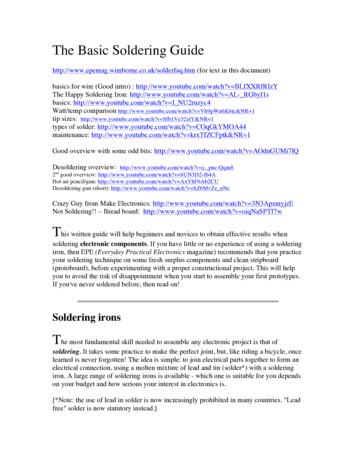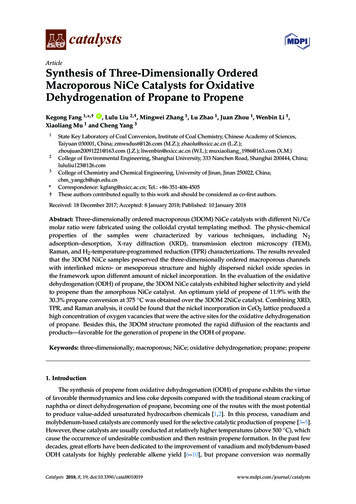
Transcription
Page 26Christophorus 347Christophorus 347Page 27SPEEDSTERNICETOHAVEAt Porsche, the concept of carrying ontradition means: movement. The new911 Speedster took to the open air of Nice,tracing the tracks of its predecessors.Photos by Achim HartmannA memorable meeting:The Mediterranean idyll ofthe Nice region is theperfect setting for a generational rendezvous, withthe Speedster that startedit all—the 356—meetingthe fourth generation:the new 911 Speedster
Page 28Christophorus 347Christophorus 347Gone with the wind:Driving in a Speedster isa matter of taste. Whereelse could the sea air bequite so sublime?Page 29
Page 30Christophorus 347Christophorus 347Narrow-gauge romanticism:The Speedster exhibits itsvery open qualities asit navigates narrow streets,rubbing shoulders withits surroundingsPage 31
Page 32Christophorus 347Christophorus 347Generations together:Model history all lined up,with the 911 Speedster(2010), the 356Speedster (1954), andthe 911 Carrera 3.2Speedster (1988)911 SPEEDSTEREngine: Six-cylinder boxerDisplacement: 3,800 ccPower: 408 hp (300 kW)Maximum torque:420 Nm at 4,200–5,600 rpm0–100 km/h: 4.4 sec.Top track speed:305 km/h (190 mph)CO2 emissions: 242 g/kmFuel consumptionCity: 15.5 l/100 kmHighway: 7.3 l/100 kmCombined: 10.3 l/100 kmPage 33
Page 34Christophorus 347Christophorus 347SPEEDSTER20102011To heaven and back in Pure Blue:The 911 Speedster comesin a limited edition of356 vehicles.THE SKY’STHE LIMITThe Porsche Speedster is considered a fresh-air delight for anyone whowants a little more than a Cabriolet. But the times when one had torelinquish a little comfort in the process have passed. As a special luxurymodel from Porsche Exclusive, the new 911 Speedster once again ridesthe winds that its fans wouldn’t want to do without.By Roland Schreiber Photos by Boris SchmalenbergerPage 35
Page 36Christophorus 347Christophorus 347Page 3719541957Developed as an entry-level modelfor the USA: The 356 Speedsterattracted attention not juston the racetrack.
Page 38Christophorus 347Christophorus 347At some point racing was no longer limited to the track. Americans, who used toswear by tail fins that practically neededfi rearm licenses, became increasinglyenamored of small sports cars from Europe in the 1950s. With the 356, Porschewas definitely on the right course. Agileand fast, the 356 provided all manner ofpleasure. And it left a big impression, onboulevards as well as at popular weekendracing events. But the British also recognized the trend and sent their roadstersover the pond—at rather favorable prices.The challenge was to beat them. Porscheimporters Max Hoffman (East Coast) andJohn von Neumann (West Coast) pleadedwith the company: the United States needed an entry-level Porsche, a light versionof the comfortable 356 America Roadster,equipped with the basics but sufficientlyattractive to draw attention on the boulevards. And it had to be sufficiently powerful to win on those racing weekends. Itsprice was not to exceed 3,000.requiring considerable manual effort toclose. This special car cost 2,995, heating and tachometer extra. It did not evenhave a fuel gauge; a dipstick was used tomeasure the fuel level. But in return, theSpeedster promised enormous freedom anda fascinating lightness to anyone who coulddo without comfort. Seventy kilos lighterthan the cabriolet, its 55-horsepower, fourcylinder boxer engine offered completelynew performance opportunities. True to theU.S. sales strategy of “Win on Sunday, sellon Monday,” John von Neumann drove thepurist newcomer at its fi rst racing event inTorrey Pines, California, on Thanksgivingweekend—and promptly won the 1.5-literclass for standard-series sports cars.The Porsche 356 Speedster celebrated itspremiere in 1954. Its windshield was excitingly narrow, its side windows had to behidden. Its roof was a bad-weather coverAt the recent Paris Motor Show, Porsche’slatest interpretation of this extreme cabriolet celebrated its world premiere. Thecompany’s specialists from Porsche Exclu-20102011Some 1,800 of these cars were sold in thefi rst year, and precisely 4,854 by 1957. Thatwas it. The Speedster’s career seemed asshort as its front windshield, which, on theother hand, has always been known forproviding breathing space.sive gave the new 911 Speedster its specialcharacter—one that is irresistibly noble.Only 356 of these vehicles will be made byExclusive Manufaktur. It is a car for truefans, a collector’s item available in two colors—Pure Blue and Carrara White—andit leaves no wish unfulfilled: bi-xenon, dynamic steering-dependent headlights, ParkAssist, aluminum doors, the Sport ChronoPackage Plus, Porsche Ceramic CompositeBrakes (PCCB), PASM suspension (lowered by 10 millimeters, or 0.4 inches), mechanical rear-axle differential lock, Porschedouble-clutch transmission (PDK), and a408-horsepower boxer engine. It also features a broader rear with the typical Speedster roof compartment cover, SportDesignfront paneling, specialty paintwork, and anew interpretation of the legendary Fuchsrim for the wheels. Its interior has smoothfinish black leather along with aluminumand ceramics fittings, adaptive sports seatswith a checkered-flag motif, illuminateddoor sills, and a limited-edition plaque. Thelove of detail is evident absolutely everywhere. The only reminders of the car’s purist pioneering days are its raked windshield,which is 60 millimeters (2.4 inches) lower,and its manually operated top.A car for individualists, but that has always been the case with the Speedster.Anyone who values wind over hairstyleshad to wait well over 30 years for the nextbig whirlwind after the 356 Speedster. Atthe International Motor Show (IAA) inFrankfurt in 1987, Porsche presented aSpeedster club sport study: a 911 that hadno front windshield at all. Its all-roundpaneling made it a single-seater. The roadversion, the 911 Speedster 3.2, followed ayear later and placed a premium on musculature. Its suspension, tires, wheels,and broad body came from the TurboCabriolet, and it had a bullish hump onits rear made of fiberglass-reinforcedplastic.A sharply angled front windshield 80 millimeters (3.15 inches) lower than its counterpart in the cabriolet, coupled with thebad-weather top, clearly marked this powerful vehicle as a Speedster, not to mentionits weight reduction of 70 kilos (154 lbs.).This set the stage for the following marketing message: “A Cabriolet is a closed carthat you can drive with the top down. ASpeedster is an open car that you can drivewith the top up.” Porsche made 2,103Speedsters with the Turbo-look until theyear 1989. And only 171 of the versionwith the narrower body.In the third generation, Porsche returnedto its original idea and focused once againon a purist and sports-oriented character.The 911 Carrera 2 Speedster of 1992 hadto keep out of car-washing tunnels. Itstop and its side mirrors had to be movedby hand. The car had no door pockets oremergency seats, and leather straps servedas door handles. The unconventional frontwindshield and the double bubble on therear had long become its trademarks.The Speedster could accelerate from 0 to100 km/h (62 mph) in 5.7 seconds, so theads picked up on tempo as well: “Pleasurein a real sports car can only be increasedby leaving half of it off. Preferably thetop half.”The Speedster is now enjoying its fourthspring, this time as a fascinating luxuryobject that is true to form. The Speedsterhas always represented luxury; one justhas to know how to appreciate it—noother Porsche can match this car in its dedication to the open road.19881989911 CARRERA 3.2 SPEEDSTERTURBOLOOKPeriod: 1988–1989Production: 2,103 vehiclesEngine: Six-cylinder boxerDisplacement: 3,164 ccPower: 231 hp at 5,900 rpm0–100 km/h: 6.3 sec.Top track speed: 245 km/h (152 mph)19921993911 CARRERA 2 SPEEDSTERPeriod: 1992–1993Production: 930 vehiclesEngine: Six-cylinder boxerDisplacement: 3,600 ccPower: 250 hp at 6,100 rpm0–100 km/h: 5.7 sec.Top track speed: 260 km/h (162 mph)911 SPEEDSTER356 SPEEDSTER 1500PHOTO SESSIONPeriod: October 2010 –June 2011Production: 356 vehiclesEngine: Six-cylinder boxerDisplacement: 3,800 ccPower: 408 hp (300 kW)Maximum torque: 420 Nm at 4,200–5,600 rpm0–100 km/h: 4.4 sec.Top track speed: 305 km/h (189 mph)CO2 emissions: 242 g/kmFuel consumption– City: 15.5 l/100 km– Highway: 7.3 l/100 km– Combined: 10.3 l/100 kmPeriod: 1954–1957Production: 4,854 vehiclesEngine: Four-cylinder boxerDisplacement: 1,488 ccPower: 55 hp at 4,400 rpm0–100 km/h: 17 sec.Top track speed: 160 km/h (99 mph)Did you enjoy the Speedster feelingfrom the two lead photos? That’s great!Photographer Boris Schmalenbergerand the Christophorus graphic artistshad to use a few tricks, because if theSpeedster does not go to the road,the road has to come to the Speedster.So they first found the right photos,made a backdrop out of them (3.0 x4.5 meters; 9.8 x 14.8 feet), set themup with the right perspective, adjustedthe lighting, and took the shots.19541957Page 39
Christophorus 347Page 47TECHNOLOGYTOP FORMMany features of the 911 Speedster differ from those of the Cabrio—includingthe soft top. Newly developed, this manually operated constructionmaintains a tight seal even at speeds of 300 km/h (186 mph).By Peter WeidenhammerOpen or closed: every once in a great while,the 911 Speedster will be driven with thetop on. So it would not be complete—either as a work of art or as an experience—unless it had a top. That is why this twoseater features a top perfectly tailored toits contours, one that not only functionswith the precision of a Swiss watch but alsois operated like those timepieces as well,namely, by hand. The engineers have developed a mechanical work of art unparalleled among tops throughout the world.In contrast to its classical predecessors, thespan element in the rear part of the top simply lies on the lid of its compartment. A lockon the top was out of the question for aesthetic reasons—no clasp and certainly nohole should disrupt the curved aesthetic ofthe aluminum lid of the top compartment.Yet in order for the outer contour to exhibitthe desired flow, and to ensure the interiorenjoys the necessary tight seal, the engineers produced a kinetic system that useslandau bars on the inside. In this design, thelandau bars press the top’s fabric seal ontothe lid of the compartment so effectivelythat it is watertight. Connected to the mechanical components of the top by meansof an intelligent kinetic system, the bars securely prevent water or drafts from enteringthe interior, even at speeds exceeding300 km/h (186 mph).The top does all of this without requiring any particular muscle power fromthe driver. The kinetic system is adjustedin such a way that any driver—whetherTotally tight: When the top is closed, the rear sealis pressed against the lid of the top compartmentphysically powerful or not—can easilyopen and close it by hand. Regardless ofthe stage in which the top is released, it remains in that position and moves neitherforward nor backward—demonstratingperfect balance in its mechanics. Thanksto the gear ratio in the two manual levers,no great strength is needed to make theclosed top taut either.A special production process for the lightweight metal rods also ensures there is noplay in the mechanical construction, yet itstill can be easily moved. Just like a Swisswatch.911 SPEEDSTEREngine: Six-cylinder boxerDisplacement: 3,800 ccPower: 408 hp (300 kW)Maximum torque: 420 Nm at 4,200–5,600 rpm0–100 km/h: 4.4 sec.Top track speed: 305 km/h (190 mph)CO2 emissions: 242 g/kmFuel consumption– City: 15.5 l/100 km– Highway: 7.3 l/100 km– Combined: 10.3 l/100 km
At Porsche, the concept of carrying on tradition means: movement. ! e new 911 Speedster took to the open air of Nice, tracing the tracks of its predecessors. Page 28 Christophorus 347 Christophorus 347 Page 29 Gone with the










